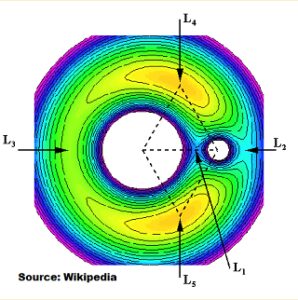
James Webb arrives at his destination
Exactly one month ago, the new James Webb Space Telescope observatory (JWST Nasa) arrived yesterday at 17:00 (Brasília time) in a region where with a minimum of fuel consumption he will be able to remain in orbit, called the Lagrange L2 point, which is actually a region between the Earth and the Sun where the centripetal (attractive) force is balanced with a centrifugal force.
observatory (JWST Nasa) arrived yesterday at 17:00 (Brasília time) in a region where with a minimum of fuel consumption he will be able to remain in orbit, called the Lagrange L2 point, which is actually a region between the Earth and the Sun where the centripetal (attractive) force is balanced with a centrifugal force.
In fact, they are regions and therefore called orbital islands, every planet in the solar system has Lagrange Points and as they move away from the Sun these islands are larger, the island related to the earth is about 800,000 km wide, the which in spatial terms is small, the point L2 for example is 5 million km from Earth and still very far from Mars, 57.6 million is the distance from our neighboring planet.
The observations will still take 5 months to calibrate all equipment, adjust the mirror and aim for the first targets.
Now it will be 5 months of work for Webb to send the first images on his “targets in the infrared universe”, he will not look for exoplanets or new points, but point to known points and make measurements more precise and with greater definition, Webb’s mirrors ( hexagonal) that should have a complicated and fine adjustment will have up to 5 times the power of Hubble’s mirrors, in addition to using a more sophisticated technology that is infrared, where you can “see” by observing the light strongly “deflected to the red” of distant objects and can peer through clouds of murky dust, it will be able to sift through exoplanet atmospheres identifying gases with greater precision.
More than 1,000 teams of astronomers from around the world have requested time on the Webb in its first year and 287 have already been lucky enough to be pioneers, among the questions from these teams are looking at the ice-covered oceans on Uranus’ 27 moons, the icy giants Uranus. and Neptune can explain much of the origin of galactic systems, look at black holes that are of average size and resolve conflicting measurements on the rate of expansion of the universe and generally speaking will use Webb for two dominant themes: time and distance between opposite extremes in the universe. universe: the early universe and the closest planetary systems and their dilemmas.
In addition to these great themes, a topic that arouses curiosity, although it is due to a childish aspect of aliens, is what is called biosignature, that is, real conditions of life, which in fact do not find “beings” but the conditions of past or future existence. of them are: gaseous, direct or indirect products of the metabolism of living beings, of surface, of spectral results resulting from the radiation reflected by organisms, and, temporal, which are responses related to seasonal changes in the biosphere where there is, for example, diurnal and nocturnal variation of CO2, some biosignatures can be found, beings are still left to the imagination, it is clear that some biological form can exist in such an infinite space of probabilities.









